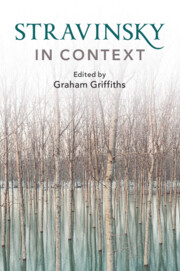Book contents
- Stravinsky in Context
- Composers in Context
- Stravinsky in Context
- Copyright page
- Contents
- Illustrations
- Contributors
- Preface
- Abbreviations
- Frontispiece
- Epigraph
- Part I Russia and Identity
- Chapter 1 Memory and Truth: Stravinsky’s Childhood (1882–1901)
- Chapter 2 Religion, Life and Death in St Petersburg
- Chapter 3 Leokadiya Kashperova and Stravinsky: The Making of a Concert Pianist
- Chapter 4 Reminiscences of Rimsky-Korsakov, His Family and Artistic Circle
- Chapter 5 Orthodoxies and Unorthodoxies: Stravinsky’s Spiritual Journey
- Chapter 6 The Russian Soul
- Part II Stravinsky and Europe
- Part III Partnerships and Authorship
- Part IV Performance and Performers
- Part V Aesthetics and Politics
- Part VI Reception and Legacy
- Recommendations for Further Reading and Research
- Index
- Endmatter
Chapter 2 - Religion, Life and Death in St Petersburg
from Part I - Russia and Identity
Published online by Cambridge University Press: 03 December 2020
- Stravinsky in Context
- Composers in Context
- Stravinsky in Context
- Copyright page
- Contents
- Illustrations
- Contributors
- Preface
- Abbreviations
- Frontispiece
- Epigraph
- Part I Russia and Identity
- Chapter 1 Memory and Truth: Stravinsky’s Childhood (1882–1901)
- Chapter 2 Religion, Life and Death in St Petersburg
- Chapter 3 Leokadiya Kashperova and Stravinsky: The Making of a Concert Pianist
- Chapter 4 Reminiscences of Rimsky-Korsakov, His Family and Artistic Circle
- Chapter 5 Orthodoxies and Unorthodoxies: Stravinsky’s Spiritual Journey
- Chapter 6 The Russian Soul
- Part II Stravinsky and Europe
- Part III Partnerships and Authorship
- Part IV Performance and Performers
- Part V Aesthetics and Politics
- Part VI Reception and Legacy
- Recommendations for Further Reading and Research
- Index
- Endmatter
Summary
By the time Stravinsky had penned his first musical epitaph Funeral Song (1908), marking the death of his teacher Nikolai Rimsky-Korsakov, the twenty-six-year-old composer had already witnessed many deaths; during his childhood and youth he often experienced the pain of losing close relatives, friends and peers. As residents of St Petersburg, then the capital of the Russian Empire, Fyodor Stravinsky and his family had attended many a funeral ceremony and bade farewell to several notable Russian musicians, writers and statesmen. The composer was already in his fifties when he published his autobiography Chronicle of My Life (1936), yet he chose to mention these events only briefly. Much later, in his eighties, possibly because he was approaching the final years of his own life, Stravinsky revisited these episodes in conversation with Robert Craft and described them in poignant detail. He would open up, too, about his emotions, revealing that he had never been able to erase such raw experiences from his memory. Even after many decades had passed he could still recall the appearance of the deceased persons lying in state and his own feelings as he filed past their open coffin.
- Type
- Chapter
- Information
- Stravinsky in Context , pp. 16 - 23Publisher: Cambridge University PressPrint publication year: 2020

